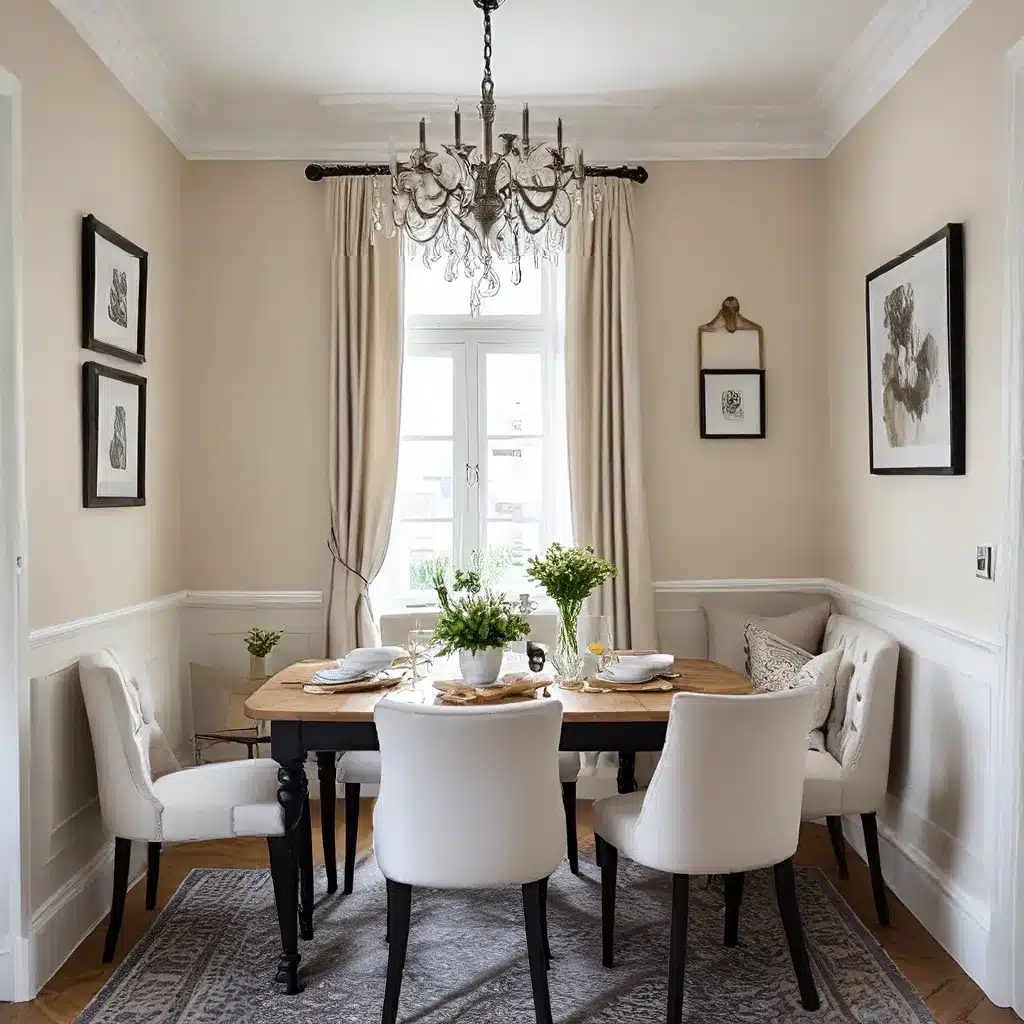
In the world of interior design, one size does not fit all. When it comes to dining rooms, the challenge of creating a stylish and functional space is amplified in compact quarters. Diminutive dining rooms, though limited in square footage, present a unique opportunity to showcase your design prowess and create an intimate, inviting atmosphere.
Maximizing Space through Strategic Placement
The key to designing a captivating diminutive dining room lies in understanding how to optimize every inch. Start by carefully considering the placement of your furnishings. Choose a dining table that fits the scale of the room, leaving enough clearance for chairs to be pulled out comfortably. Opt for a circular or oval table to maximize seating and traffic flow, rather than a bulky rectangular option that can overwhelm a small space.
Complement the table with slender, streamlined chairs that don’t visually occupy too much space. Banquettes or built-in seating along the walls can also be a space-saving solution, providing extra seating without encroaching on the room’s footprint. Consider dual-purpose furniture, such as a console table that can double as a buffet or a bar cart that serves both storage and serving needs.
Urban Grace Interiors emphasizes the importance of scale and proportion when furnishing a diminutive dining room. “Every piece you select should be carefully measured to ensure it fits harmoniously within the space,” explains Principal Designer Grace Mitchell. “Avoid oversized or bulky pieces that can make the room feel cluttered and cramped.”
Enhancing Lighting and Reflective Surfaces
Proper lighting is essential in a small dining room, as it can create the illusion of depth and airiness. Pendant lights or chandeliers suspended above the table draw the eye upward, making the space feel more expansive. Strategically placed sconces or recessed lighting can also contribute to a well-lit, inviting ambiance.
Incorporate reflective surfaces to amplify the effect of your lighting and create a sense of visual depth. Mirrored or glass-topped furniture, such as a console table or sideboard, can bounce light around the room, making it appear larger. Shiny hardware, metallic accents, and high-gloss finishes on walls or cabinetry also enhance the reflective qualities of the space.
Embracing Vertical Elements
When floor space is limited, look to the vertical elements of your dining room to create visual interest and a sense of grandeur. Tall, slender bookcases or display shelves flanking the dining area can draw the eye upward, making the room feel more expansive. Hang floor-to-ceiling curtains to elongate the walls and give the illusion of height.
Designer Holly Holden suggests exploring unexpected design choices for the ceiling, such as painting it a complementary color to the walls or incorporating whimsical artwork. “Most guests rarely look up to the ceiling until they begin to feel notably comfortable in their surroundings,” Holden notes. “Something other than white can be an unexpected treat for your guests’ eyes to discover.”
Embracing Multifunctional Design
In a diminutive dining room, versatility is key. Look for furniture and decor that can serve multiple purposes, maximizing the functionality of the space. A sideboard or credenza can provide storage, display space, and a surface for serving and entertaining. Built-in cabinetry or a custom-designed banquette with integrated storage can also help keep the room clutter-free.
Designer Garrett Hunter emphasizes the importance of comfortable seating in a small dining room, noting that it can create an intimate, cozy atmosphere. “The key is to consider consistent seat heights in a dining room,” he explains. “It worked well because that sofa sits tall and it created an intimate dining experience within an open area.”
Embracing Color and Pattern
While a neutral color palette can create a serene, sophisticated atmosphere, don’t be afraid to infuse your diminutive dining room with bold color and pattern. Vibrant hues and dynamic prints can help visually expand the space, drawing the eye around the room and creating a sense of depth.
Landscape designer Nick Dean shares his approach to transforming a small dining area: “We knew we wanted to have as much big open space as possible, so we created distinct groupings of furniture to delineate different functions.” By incorporating electric blue chairs and a crimson antique tapestry, Dean was able to inject personality and visual interest into the compact room.
Striking the Balance Between Functionality and Elegance
Designing a diminutive dining room requires a delicate balance between functionality and elegance. By thoughtfully selecting scaled-down furnishings, incorporating strategic lighting and reflective surfaces, and embracing vertical elements and multifunctional design, you can transform even the smallest of dining spaces into a petite perfection.
Remember, the true mark of a successful diminutive dining room is one that feels inviting, comfortable, and tailored to your unique lifestyle. With a little creativity and attention to detail, you can create a dining experience that belies its compact footprint, leaving your guests delighted and inspired.

